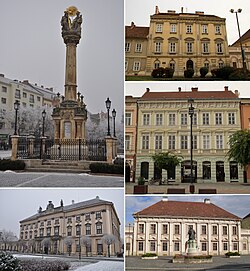Sabaria
| Szombathely | ||
|---|---|---|
| City | ||
 |
||
|
||
| Location of Szombathely | ||
| Coordinates: 47°14′06″N 16°37′19″E / 47.23512°N 16.62191°ECoordinates: 47°14′06″N 16°37′19″E / 47.23512°N 16.62191°E | ||
| Country | Hungary | |
| County | Vas | |
| Government | ||
| • Mayor | Tivadar Puskás (Fidesz-KDNP) | |
| Area | ||
| • Total | 97.52 km2 (37.65 sq mi) | |
| Elevation | 209 m (686 ft) | |
| Population (2011) | ||
| • Total | 79,590 | |
| • Rank | 10th | |
| • Density | 821.92/km2 (2,128.8/sq mi) | |
| Time zone | CET (UTC+1) | |
| • Summer (DST) | CEST (UTC+2) | |
| Postal code | 9700 | |
| Area code(s) | 94 | |
| Website | www |
|
Szombathely (Hungarian pronunciation: [ˈsombɒthɛj]; see also other alternative names) is the 10th largest city in Hungary. It is the administrative centre of Vas county in the west of the country, located near the border with Austria. Szombathely lies by the streams Perint and Gyöngyös (literally "pearly"), where the Alpokalja (Lower Alps) mountains meet the Little Hungarian Plain. The oldest city in Hungary, it is known as the birthplace of Saint Martin of Tours.
The name Szombathely is from Hungarian szombat, "Saturday" and hely, "place", referring to its status as a market town, and the medieval markets held on Saturday every week.
The Latin name Savaria or Sabaria comes from Sibaris, the Latin name for the stream Gyöngyös. The root of the word is the Proto-Indo-European word seu, meaning "wet". The Austrian reach of the stream is still called Zöbern, a variation of its Latin name. The city is known in Croatian as Sambotel, in Slovene as Sombotel and in Yiddish: סאמבאטהעלי).
The German name, Steinamanger, means "stone on a field" (Stein am Anger). The name was coined by German settlers who encountered the ruins of the Roman city of Savaria.
Szombathely is the oldest recorded city in Hungary. It was founded by the Romans in 45 AD under the name of Colonia Claudia Savariensum (Claudius' Colony of Savarians), and it was the capital of the Pannonia Superior province of the Roman Empire. It lay close to the important "Amber Road" trade route. The city had an imperial residence, a public bath and an amphitheatre. In 2008, remains of a mithraeum were discovered.
...
Wikipedia


